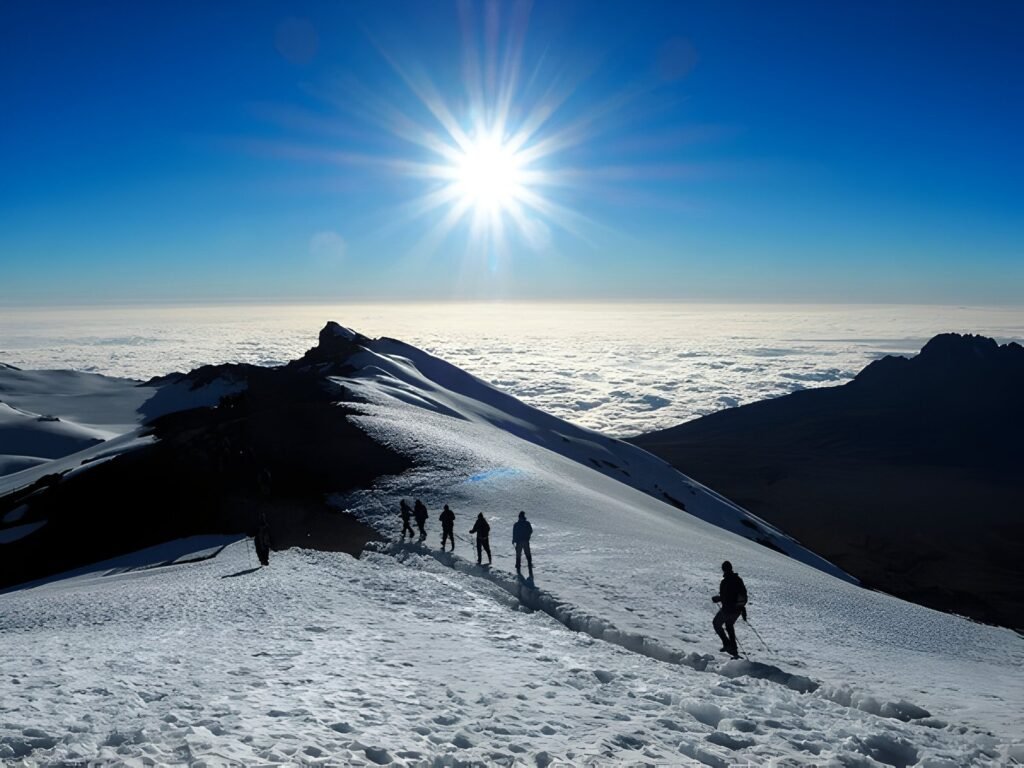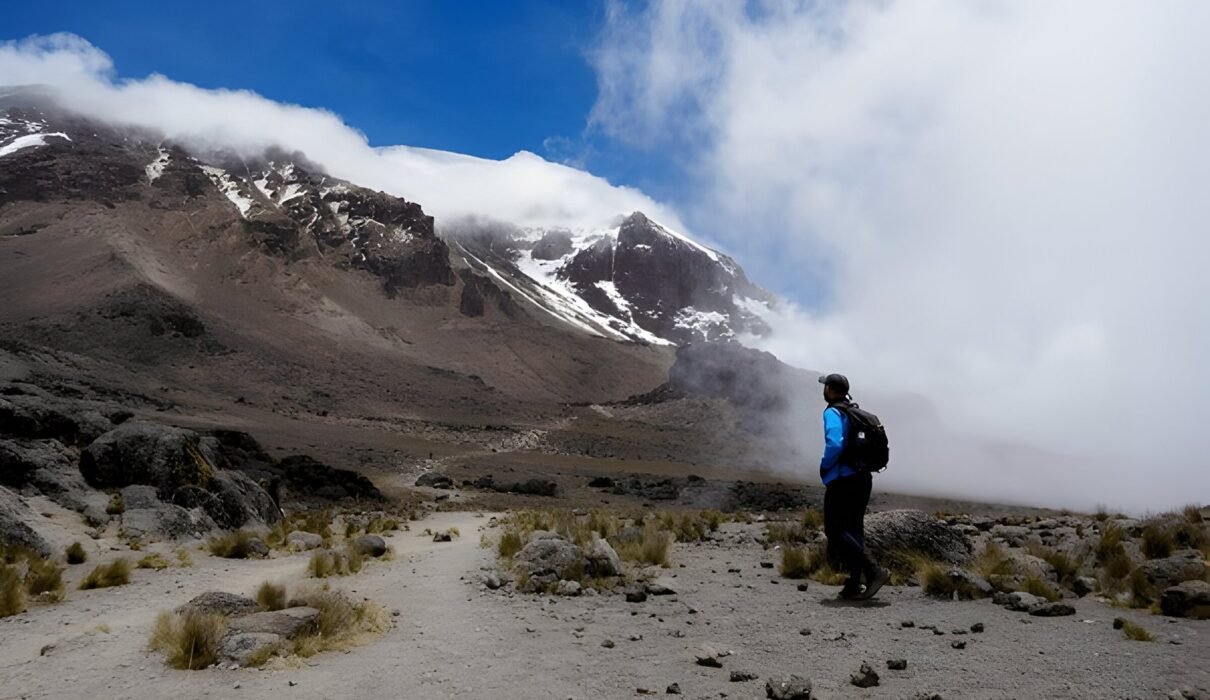Climbing Mount Kilimanjaro, the tallest mountain in Africa and one of the Seven Summits, is an adventure that draws trekkers from around the world. Standing at 5,895 meters (19,341 feet), Kilimanjaro is a non-technical climb, meaning it doesn’t require advanced mountaineering skills. However, summiting this iconic peak still presents challenges, including altitude, variable weather, and long days of hiking. In this guide, we’ll cover everything you need to know about successfully reaching the top of Kilimanjaro, from selecting the right route to essential gear and preparation tips.
Start planning your Kilimanjaro adventure.

1. Why Mount Kilimanjaro Is the Best of the Seven Summits
While all of the Seven Summits (the highest mountains on each continent) offer unique challenges, Kilimanjaro stands out for several reasons. It’s the tallest free-standing mountain in the world and features five distinct climate zones, offering a visually stunning and varied trek. Unlike more technical climbs such as Mount Everest or Denali, Kilimanjaro is accessible to non-climbers, making it a popular choice for those seeking a once-in-a-lifetime trekking experience.
Key Highlights:
- No Technical Climbing Required: Kilimanjaro is achievable for trekkers without technical climbing experience.
- Diverse Ecosystems: From rainforests to alpine deserts, Kilimanjaro offers a unique and changing landscape as you ascend.
- Personal Challenge: Conquering Kilimanjaro is a mental and physical challenge, making the summit even more rewarding.
Learn more about Kilimanjaro’s unique landscapes.
2. Choosing the Right Route for Your Kilimanjaro Climb
Mount Kilimanjaro has several routes to the summit, each offering different levels of difficulty, scenery, and acclimatization periods. Choosing the right route is key to maximizing your chances of reaching the top successfully.
Popular Kilimanjaro Routes:
- Machame Route (7 days): Known as the “Whiskey Route,” this is the most popular choice, offering beautiful scenery and a good acclimatization profile.
- Marangu Route (6 days): The “Coca-Cola Route” is the only one with hut accommodations, making it more comfortable for some climbers, though it has a lower summit success rate due to shorter acclimatization time.
- Lemosho Route (8 days): Known for its remote and scenic path, the Lemosho Route is ideal for trekkers looking for fewer crowds and a higher success rate due to its longer duration.
- Rongai Route (7 days): Approaching from the north, this quieter route offers a different perspective of the mountain with less rainfall.
Explore detailed Kilimanjaro route options here.
3. Understanding Altitude and Acclimatization on Kilimanjaro
One of the biggest challenges of climbing Kilimanjaro is adjusting to the altitude. At nearly 6,000 meters, altitude sickness is a real risk, and the best way to prevent it is through proper acclimatization. The longer you spend on the mountain, the better your chances of adapting to the thin air, which is why choosing a route with more days on the mountain is highly recommended.
Acclimatization Tips:
- Climb High, Sleep Low: Many routes follow this principle, allowing your body to adjust to higher altitudes while sleeping at lower elevations.
- Hydration: Drink plenty of water to combat the effects of altitude.
- Pace Yourself: Go “pole pole” (slowly, slowly in Swahili) to give your body time to adjust.
Learn more about altitude sickness and how to prevent it.
4. Essential Gear for Climbing Kilimanjaro
Having the right gear can make or break your Kilimanjaro experience. As you move through different climate zones, you’ll need to be prepared for everything from hot and humid conditions to freezing temperatures near the summit.
Key Gear Items:
- Hiking Boots: Comfortable, waterproof boots with ankle support are essential for tackling Kilimanjaro’s rugged terrain.
- Layered Clothing: A good layering system is crucial for regulating body temperature. Start with a moisture-wicking base layer, add an insulating mid-layer, and top it with a waterproof outer layer.
- Down Jacket: For the summit night, a high-quality down jacket is necessary to keep you warm in freezing temperatures.
- Sleeping Bag: A four-season sleeping bag rated for sub-zero temperatures will ensure you stay warm at night.
- Trekking Poles: Trekking poles help reduce strain on your knees during long descents and provide stability on uneven terrain.
Find out more about the essential gear for Kilimanjaro.
5. Preparing Physically and Mentally for Kilimanjaro
Although Kilimanjaro doesn’t require technical climbing skills, the trek is physically demanding. Training for the climb is key to building the strength, endurance, and mental toughness needed to reach the summit.
Training Tips:
- Hiking: Regular hikes with a loaded backpack will help build the stamina and leg strength required for long days on the trail.
- Cardio Workouts: Running, cycling, or swimming will help improve your cardiovascular fitness, which is crucial for coping with the high altitudes.
- Strength Training: Focus on building core and leg strength through exercises like squats, lunges, and stair climbing.
- Mental Preparation: Kilimanjaro is as much a mental challenge as it is a physical one. Staying motivated, focusing on small goals, and pushing through tough moments will be essential to your success.
Get more tips on training for Kilimanjaro.
6. What to Expect on Summit Night
Summit night on Kilimanjaro is the most challenging part of the climb. Starting around midnight, you’ll trek in the dark to reach the summit by sunrise. The ascent is long, steep, and cold, but reaching Uhuru Peak and watching the sun rise over the African plains is an unforgettable experience.
Tips for Summit Night:
- Pace Yourself: The final ascent is slow and steep. Take small steps and conserve your energy.
- Stay Warm: Layer up, wear a warm hat and gloves, and make sure to have hand warmers ready.
- Hydrate and Snack: Drink water and have energy-rich snacks to keep your energy levels up during the long ascent.
Prepare for Kilimanjaro’s summit night with these tips.
7. Conservation and Responsible Tourism on Kilimanjaro
Mount Kilimanjaro is part of Kilimanjaro National Park, a UNESCO World Heritage Site, and it’s important to be a responsible traveler. Many tour operators support sustainable tourism efforts by giving back to local communities and helping to protect the mountain’s fragile environment.
How to Be a Responsible Traveler:
- Leave No Trace: Carry out all your trash, stick to designated trails, and respect wildlife.
- Support Local Communities: Choose tour operators that hire local guides, porters, and staff, ensuring that the economic benefits of tourism are shared with the local population.
- Eco-Friendly Packing: Use biodegradable toiletries and avoid single-use plastics.
Read more about responsible tourism on Kilimanjaro.
Conclusion: Your Journey to the Roof of Africa
Summiting Mount Kilimanjaro is a remarkable achievement and an unforgettable journey. With the right preparation, gear, and mindset, you can successfully reach the top of Africa’s highest peak. Whether you’re drawn by the physical challenge, the stunning landscapes, or the sense of adventure, Kilimanjaro offers an experience unlike any other.
For expert advice and tailored Kilimanjaro climbing packages, visit Kilimanjaro Climb Specialist or Eddy Tours & Safaris.

